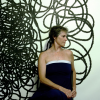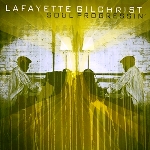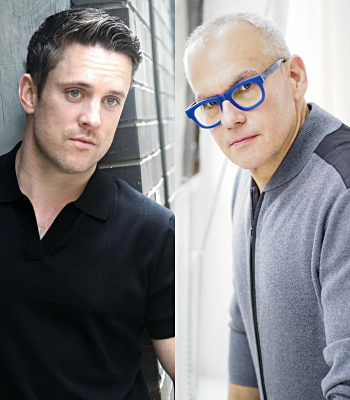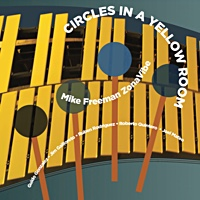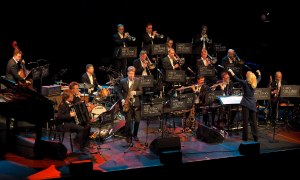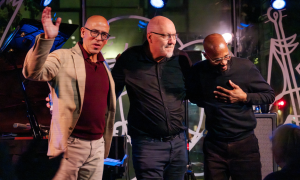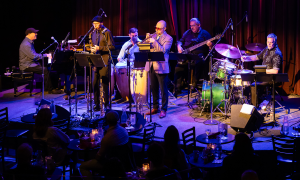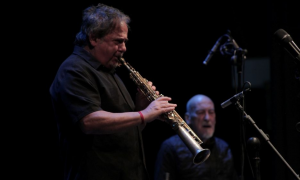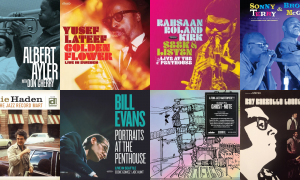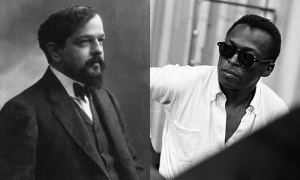Home » Jazz Articles » Live Review » Rob Schwimmer at the Northampton Center For The Arts, No...
Rob Schwimmer at the Northampton Center For The Arts, Northampton, MA
It's tempting to project that Schwimmer's autodidactic competence on the theremin has bled over into how he makes sound on the piano.
Northampton Center for the Arts
Northampton, Massachusetts
September 12, 2008

It is against human nature to live in a vacuum: individuals can't grow without interaction with their environment. The same is true for all creative arts, none of which would have changed or developed without creative minds capable of reaching out beyond the isolated self to external sources, even those not normally associated with the art being made. Pianist and thereminist Rob Schwimmer draws from multiple fields to enrich his innate musicality. There was no better time to observe this artist's assimilation of diverse influences than his performance at the Northampton Center for the Arts on this Friday night.
Schwimmer exhibited great capacity for equally engaging his instruments and his audience, while demonstrating a singular determination to achieve clarity.
At the onset of the program, his approach to the piano was wordless. Suited in charcoal grey and black and wearing rimless glasses, his long, brownish blond hair tied with a red band into a double-knotted ponytail, he strode to the piano bench, sat down, took a breath and placed his hands carefully on the keyboard. Methodically and at slow tempo Schwimmer played several chords in succession, some in a minor modality. His right hand next unwound a melody in the treble keys, as the bass chords became fewer. His hands came together for playing synchronized chords up and down the keyboard. Then he stopped. His attitude seemed to change, as suddenly he was off on a new course, his fingers flying so fast that the fluttering resembled electronic sounds.
The music rose to crescendos, which were juxtaposed with subtle and quiet gestures, as Schwimmer played improvised as well as prepared compositions. Even amidst the variety, contrasts and flow, Schwimmer managed to blend the numerous pieces of the program, including presentations of the songs, into a continuous performance. After he rose from the bench following the conclusion of a musical segment, he related to the audience that he had just played two or three pieces... they had merged into one. Only in retrospect, and by listening to a recording, could the tunes have been distinguished one from the other. Several times, the pianist stopped, after the fact, to inform the audience of the titles of songs he had played. Such pauses, moreover, were occasionally accompanied by interjected humorous tales. Schwimmer was not merely embellishing his performance but doing his very best to invite and draw the audience to the music.
Apart from his speaking, his piano playing exuded the programmatic, unveiling story after story. His posture at the keyboard was muscular, the manner in which he moved his short fingers precisely through the keys, fascinating simply to watch. Every note registered more than tone; every note evoked a range of feelings and textures from sincerity and forgiveness to gentleness and softness.
Schwimmer is a romantic at heart. The emotive ornamentation, the flourishes, the stopping and the starting, the fluidity, the mellifluous runs up and down the keyboard transformed the pianistic experience into one eliciting forces of nature, or elements of weather. Imagine silk scarves billowing in the wind. Or harp-like textures annotating huge melodic statements that themselves were enhanced further in hand-over-hand motion from bass to treble, along with tremolos, playful trills and still more arpeggiation. A distinctive coda always arrived.
Despite the deep and moving currents, nothing that the piano said was disconcerting; rather sensuality undulated throughout the resonating flurries of high notes or the pounding of the bass strings in the sounding board. The pianist's repertoire ranged from standards ("When You Wish Upon A Star" and "Stormy Weather") to original compositions ("Talk with My Dad" and "Hello Again") to spontaneous improvisation. Schwimmer doubtlessly could play any music that was put in front of him, virtuoso that he is.
The theremin alluded to earlier has a strong role in his performance. Indeed, the strange instrument stood there as if a part of the audience listening to Schwimmer's piano-playing. His affection for the rarely heard instrument comes through vividly in his spoken descriptions of how it works and how it originated. Although he's likely given the same introduction and performance hundreds of times, the repetition does not distract from his undivided focus when he extracts, from the device's electromagnetic fields, sounds that resemble human voices singing, an effect he achieves by simply making the smallest changes in the positions of his knuckles, just enough to alter or disturb "the air."
Given the seeming lack of interaction with the theremin, he demonstrated that its sonic potential was on a par with the expressivity of the piano, even when appreciated as a solo instrument, unaccompanied by other instruments or sounds. It's tempting to project that Schwimmer's autodidactic competence on the theremin has bled over into how he makes sound on the piano. Perhaps the theremin's propensity for sounding melodramatic in response to the physical movements in the performer—so less tactile than the player's engagement with a keyboard to produce sound—has increased Schwimmer's attention to the manner in which he addresses the piano keyboard—caressing, coaxing, stroking it to ensure the most eloquent response.
Whether it's the result of his listening to pianists from Bud Powell to Herbie Hancock, or to the music of classical composer Frederic Rzewski, or of being awed enough after seeing the late Clara Rockmore perform on the theremin to learn how to do it himself, the mystery of how Schwimmer's music comes together is a story that writes itself as the music unfurls. What Schwimmer produces matches his self-description: "a lover of beautiful sound."
Tags
PREVIOUS / NEXT
Support All About Jazz
 All About Jazz has been a pillar of jazz since 1995, championing it as an art form and, more importantly, supporting the musicians who make it. Our enduring commitment has made "AAJ" one of the most culturally important websites of its kind, read by hundreds of thousands of fans, musicians and industry figures every month.
All About Jazz has been a pillar of jazz since 1995, championing it as an art form and, more importantly, supporting the musicians who make it. Our enduring commitment has made "AAJ" one of the most culturally important websites of its kind, read by hundreds of thousands of fans, musicians and industry figures every month.

